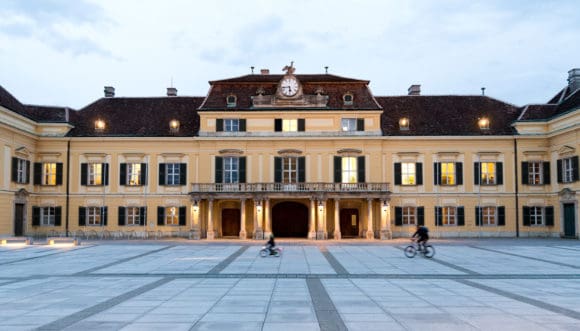By Greg Davies-Jones, 2020 IIASA Science Communication Fellow
Greg Davies-Jones finds out how COVID-19 has lightened the carbon footprint of IIASA and uncovers how the institute plans to integrate climate protection and sustainability into everyday research activities.
The impact of COVID-19 has been profound and pervasive, infiltrating deeply into many spheres of society. IIASA has not escaped the clutches of the pandemic either: The phrase ‘unprecedented times’ has become just as commonplace here at the institute as it has across the globe. Despite the overt and all too evident adverse consequences of COVID-19, there is a significant, albeit only temporary, positive aspect of a lockdown existence, namely a reduction in carbon dioxide (CO2) emissions.
At IIASA, the principal decline in CO2 emissions has been due to the drop-off in business travel. With individual mobility heavily restricted, travel arising out of research activities, meetings, and conferences has dropped to almost zero. To fill the void, the virtual world is rapidly becoming the everyday reality: Zoom calls, Skype meetings, audio hiccups, video glitches, and the occasional gallivanting toddler have fast become the norm in this new working world.

Schloss Laxenburg | ©IIASA
In the years to come, when the COVID-19 cobwebs are finally blown away (hopefully), might this new working world become more commonplace? A hybrid between the pre-COVID-19 and post COVID-19 worlds perhaps? One thing is certain: The continuation of business-as-usual will be catastrophic environmentally. A recent climate poll documented in The Guardian found despairingly that people are planning to drive and, in some cases, even fly more in the future than before the coronavirus pandemic. The dangerous inference that could be drawn from this is that, rather than merely a disconnect between individual actions and outcomes, there are conscious choices being made that are increasingly recognized as being highly inimical to the continued existence of most life forms on this planet.
Given the global shock to the economy, cost will also be a key factor influencing decisions in the post COVID-19 world. Virtual conferencing is pre-eminently a cheaper alternative. Although not a perfect substitute for in-person meetings – it does come with advantages (e.g., lower resource requirements and better accessibility) as well as disadvantages (e.g., lacking informal exchanges).
“Another aspect is inclusivity ̶ virtual conferencing affords people the opportunity to engage with relative ease (provided they have a sound internet connection), irrespective of their geographical location,” explains IIASA researcher Caroline Zimm.
Fellow researcher, Benigna Boza-Kiss, continues: “The virtual working world can be fruitful and effective, but we must be more strategic in how it is organized. Structured meetings with specific objectives planned in advance will allow for ineffectual activity and call-times, which similarly generate emissions, to be reduced.”
Notwithstanding these positives of a virtual working environment, there are some apprehensions, particularly regarding the impossibility of virtual platforms to meaningfully replicate certain types of social interactions, including those that occur outside structured sessions at conferences. Conversations beside the coffee machine, chinwags in the corridor, or even the post-work evening revelry – all such serendipitous moments and gainful interaction are considered invaluable in providing the ‘complete’ conference experience. Yet, the virtual world can offer other distinct advantages.
“In video calls and online conferencing platforms, it is not as daunting to ‘raise a hand’ or contact someone more senior. I have found that some people actually speak up more (often using the chat function) than they would in a physical conference setting. This means a shift in the networking dynamic and perhaps even greater inclusivity,” says Zimm.
The lightening of the carbon footprint of IIASA research ventures will likely be short-lived unless we make fundamental changes over the long-term. As the time window in which we can effectively act on climate change inexorably closes, it is imperative that we do more to attain the universal climate goals written into the Paris Agreement.
In light of this challenge, and considering the work of IIASA as a leader in environmental and sustainability studies, it feels appropriate to ask: Should the prevailing ethos of environmental institutes and practitioners therein openly acknowledge and embrace the responsibility to act as role models in reducing negative environmental impact? Put bluntly, should it be incumbent upon them to ‘walk the talk’? Are people more likely to respond to organizations and researchers that practice what they preach?
Many environmental institutes and researchers, at least nominally, would agree, but this purported espousal must be underpinned by concrete action. In 2019, IIASA joined forces with Climate Alliance Austria – an organization focusing on awareness-raising projects and activities to promote knowledge on climate issues and sustainable development. The IIASA-Climate Alliance mandate is to integrate climate protection and sustainability into everyday research.
To advance this philosophy, IIASA has formed an internal Environment Committee that focuses on nurturing more environmentally friendly processes and activities at the institute. To this end, the committee has organized an evaluation and is elaborating a strategy that includes developing Green Event Guidelines, powering IIASA with certified green electricity, and encouraging individual action with a ‘Bike to Work’ scheme.
For the most part however, these are all fledgling initiatives that require cultivation, top level support and leadership to ensure success. Moreover, these initiatives necessitate additional targeted and hard-hitting emission-mitigation strategies to avoid frustratingly commonplace ‘greenwashing’ and ensure decisive, positive internal climate action. More stringent measures, such as the institute’s proposed stricter sustainable procurement and travel policies, will arguably make a powerful and lasting contribution to this over-arching aim of “reconfiguring” IIASA as an employer that is doing all it can to implement and facilitate sustainable working practices for its entire workforce.
Note: This article gives the views of the author, and not the position of the Nexus blog, nor of the International Institute for Applied Systems Analysis.

You must be logged in to post a comment.